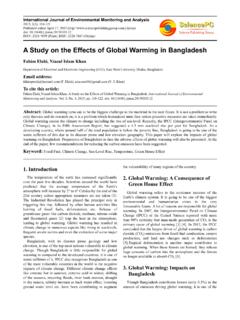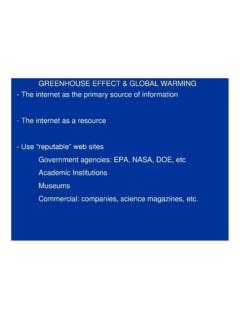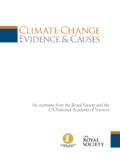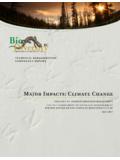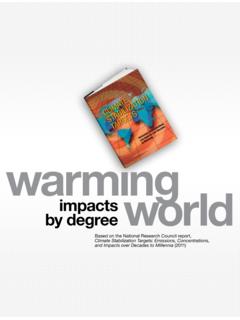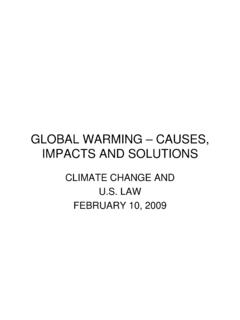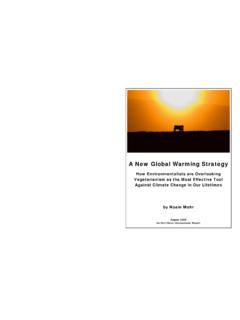Transcription of The Effect of Global Warming on Animals & Plants …
1 The Effect of Global Warming on Animals & Plants Terry L. Root Senior Fellow University Faculty Stanford University Over the last 100 years, the average Global surface temperature has warmed approximately ( ) and is projected to rise at an increasing rate over the next century. This rate of Warming is significantly larger than the rate of sustained Global Warming over the 6,000 years or so that it took for the globe to warm about 6oC from the last ice age to our current warm interglacial period. That temperature transition, which occurred about 12,000 to 18,000 years ago, represented a Warming rate of about 1oC ( ) per thousand years.
2 Extrapolating out the more recent Warming trend to a comparable 1000 years, we see that a 7oC/1000 years raise in temperature is some 7 times faster than in the last 18,000 years. As the planet continues to warm, the rate will continue to escalate. A primary concern about wild species and their ecosystems is currently they are not only having to adapt to warm temperatures, but they are also having to cope with the most rapid rate of temperature increase in the last 18,000 years. Additionally, in the pre-historic past, Plants and Animals were not under stressed due to other human-caused problems: pollution, land-use change, invasive species, and others.
3 Today the synergistic effects of these stresses combined with rapid Warming are greatly influencing the resilience (ability to return to the same condition after a stress) of many species, communities and ecosystems. What is concerning is that very noticeable changes have been measured in species over the last 30 to 40 years during which the Global temperature increased around Yet, the Summary for Policy Makers of Working Group I of the Fourth Assessment Report of the IPCC explained that the Global temperature could rise as much as and even beyond if we stay on the energy path we are currently traveling.
4 It is highly likely that all but a few species and ecosystems will be able to adapt to that amount of temperature change. By 2100 the resilience of many ecosystems is likely to be exceeded by an unprecedented combination of change in climate, associated disturbances ( , wildfire, insects), and other changes happening globally, such as land-use change, over exploitation of resources, invasive species, pollution (high confidence). Key ecosystem properties, ( biodiversity), or regulating services, ( carbon sequestration), are very likely to become impaired. When ecosystem resilience is exceeded, the response will very likely be characterized by threshold-type responses, some irreversible on time-scales relevant to human society ( , such as disruption of species ecological interactions and major changes in ecosystem structure and disturbance regimes especially wildfire 2and insects), and the loss of biodiversity through extinction being irreversible on any time scale.
5 With rapid Warming , ecosystems and species are very likely to show a wide range of vulnerabilities that depend on imminence of exposure to ecosystem-specific, critical thresholds (very high confidence). The most vulnerable ecosystems include coral reefs, the sea ice biome and other high latitude ecosystems ( boreal forests), mountain ecosystems and Mediterranean-climate ecosystems (high confidence). The least vulnerable ecosystems include savannas and species poor deserts, but this assessment is especially subject to uncertainty relating to the CO2 fertilization Effect and disturbance regimes such as fire (low confidence).
6 Since the Third Assessment Report we have many more studies analyzing the changes in the flora and fauna over longer time series. A notable number of wild Animals and Plants on all continents are already exhibiting discernible changes in response to regional climatic changes. This is as we expected, because temperature is central to the lives of all living organisms. Many Plants and Animals have and will probably continue to adjust in several ways, including: 1) shifts in the densities of populations of species either by extending their range boundaries both toward the poles ( , North in the US) and up in elevation, or populations numbers shifting from one portion of their range to another ( , the center of the abundance pattern moving up in elevation), 2), shifting in the timing ( , phenology) of various events occurring in spring, which is quit common, or autumn, which is less common, 3) changes in the genetic, behavioral, morphometrics ( , body size or egg size), or other biological parameters, and 4)
7 Local extinction or Global extinction, the latter of which is irreversible at any time scale. Changes In Ranges And Shifting Densities As the globe warms we find that species in North America are extending their ranges north and up in elevation, because habitats in these areas have now warmed sufficiently to allow colonization. The movements (dispersal) of species forced by rapidly rising temperatures, however, are frequently slowed and often blocked by numerous other human-made stresses, such as land-use changes, invasive species and pollution. Consequently, individuals that are moving north or up in elevation have to navigate around, over or across freeways, agricultural areas, industrial parks, and cities.
8 Species near the poleward side of continents (e. g., South Africa s fynbos) will have no habitats into which they can disperse as their habitat warms. The same is true for species living near the tops of mountains. Additionally, species living in these areas will be further stressed by species from farther inland or farther down the mountain moving into their habitats. Because of the heat stress and the new species with which they must interact, many species currently on islands, on the poleward side of continents and near the tops of mountains could 3go extinct unless humans move them to another location and make sure they survive there.
9 The need for species to track certain temperatures could cause wildlife managers to face a number of novel challenges over the next several decades. To date, preservation practices are generally ill prepared to deal with the challenges of rapid climate change and effective adaptation responses are likely to be costly to implement. For example, at least some managed species or species of concern will need to move as the globe warms. This could easily mean that many species currently protected in wildlife refuges or national parks could easily need to disperse to new habitats on less protected lands.
10 These new habitats occupied by these previously managed species and species of concern may not be conducive to protecting species. This is certainly a very likely problem that needs some advance thought and planning. Throughout pre-historic and more recent times, species have been found to move independently from other species in their community or ecosystem; species move at different rates and directions, depending on their unique metabolic, physiological and other requirements. This independent movement, will probably become increasingly evident the higher the temperature becomes.






